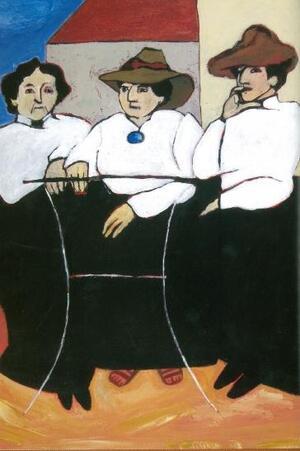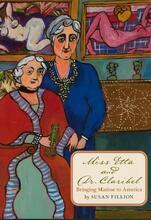Claribel Cone
Claribel Cone, Gertrude Stein, Etta Cone in Italy, 1903.
Illustration by Susan Fillion.
Used by permission of David Godine, Publisher.
Claribel Cone made contributions to two vastly different fields: as a biologist and a patron of modern French art. Cone graduated the Women’s Medical College of Baltimore in 1890 and did postgraduate work at Johns Hopkins and the University of Pennsylvania, intending to become a physician. Her internship at Philadelphia Blockley Hospital for the Insane made her decide to focus on teaching and research, becoming a professor of pathology at the Women’s Medical College of Baltimore for 25 years. Her career as a patron of the arts began in Paris in 1903, when she and her sister Etta visited Gertrude Stein—who later immortalized them in the essay “Two Women.” Over time they bought over two hundred works by Picasso, Matisse, Renoir, Cezanne, Degas, Gaugin, and others.
Immortalized in drawings by French modernists Pablo Picasso and Henri Matisse and in Gertrude Stein’s essay “Two Women,” Dr. Claribel Cone was well known in her day as a charming, dignified, well-informed, self-assured, idiosyncratic, and highly independent woman with two passions, medical research and collecting art and artifacts.
Early Life and Education
Claribel Cone was born on November 14, 1864, to German immigrants Herman and Helen (Guggenheimer) Cone (Kahn), the fifth of thirteen children. Her father had immigrated to Richmond, Virginia, in 1846 and worked as a dry-goods peddler. Within ten years he settled in Jonesboro, Tennessee, became a co-owner of a grocery store, married, and began a family. In 1871, they moved to Baltimore, where Herman opened a wholesale grocery business and purchased an elegant, spacious home on Eutaw Place in 1880, becoming part of Baltimore’s flourishing German Jewish community. On Herman Cone’s retirement, his two oldest sons and business partners sold the grocery firm and went into the textile business, moving to Greensboro, North Carolina, in the 1890s and eventually building their own mills. Cone Mills prospered, becoming the world’s leading producer of denim by the 1920s.
Young Claribel Cone loved to read and write, studied botany and German, and enjoyed playing the piano and painting watercolors. She graduated from the Baltimore Western Female High School in 1883. Though her parents encouraged marriage, Cone decided to study at the Women’s Medical College of Baltimore to become a physician. First in her class, she graduated in 1890 and undertook postgraduate study at Johns Hopkins University, the University of Pennsylvania, and the Women’s Medical College of Pennsylvania. She won one of five internships at the Philadelphia Blockley Hospital for the Insane.
Early Career
On returning to Baltimore in 1893, Claribel Cone announced that she preferred medical research and teaching to clinical practice. She secured a position as a lecturer in hygiene at the Women’s Medical College of Baltimore. Appointed full professor in 1895, she taught pathology at the college until it closed in 1910.
Between 1903 and 1913, Claribel Cone traveled to Europe nearly every summer and spent several winters at the Senckenberg Pathological Institute in Frankfurt, Germany. Her research focused on tuberculosis and the behavior of fatty tissue under normal and pathological conditions. She worked in laboratories under several distinguished pathologists and published at least two articles but did not seem to consider herself a fully established professional in her field and was grateful when mentors praised her work. “It is one of the most flattering and charming things that has ever happened to me in my life—to be approved of as woman and as worker by [Dr. E. Albrecht], one of the most talented yet critical and learned men in the world,” she wrote to her sister Etta in 1910.
Art Collecting
Claribel Cone’s competing passion was collecting “beautiful things,” which she said in 1928 that she had enjoyed “ever since I was a small girl and picked up all the shells I could find, reveling in their color and in their forms.” In Paris in 1903, Leo and Gertrude Stein introduced their Baltimore friends Claribel and Etta Cone to struggling artists Picasso and Matisse, encouraging the sisters to “indulge in romantic charity” and buy some of the artists’ work. Drawing on their inherited yearly incomes of $2,400, the Cone sisters gradually purchased works by Picasso, Matisse, Cezanne, Renoir, Degas, Gaugin, Van Gogh, and others, selecting pieces to adorn the walls of their adjoining Baltimore apartments. After World War I, high profits at Cone Mills enabled the sisters to buy more expensive oil paintings. At Etta’s death in 1949, their extensive and world-famous art collection featured over two hundred works by their favorite, Henri Matisse, spanning fifty-two years.
Cone continued to work and study with medical colleagues while living in Munich from 1914 to 1921. Despite her delight in intellectual and social companionship, Cone always lived alone after she left the family home. Her Munich letters report nearly daily social engagements and frequent trips to the opera, concerts, and plays, though she commented in 1920, “On the whole I find things so much more satisfactory than people—people are interesting but you cannot live with them as satisfactorily as with things—things are soothing—if they are works of art—most people are overstimulating.”
Though described by a nephew as a “freethinker,” Claribel Cone was quite conscious of her identity as a Jew. She often commented on colleagues’ ethnic identities and labeled herself a Jewess. Her family belonged to a local Reform temple, observed some religious holidays, and maintained strong ties with other German Jews, but, like many immigrant families, they emphasized Americanization, insisting that their children speak and write in English. Because she lived abroad much of her adult life, Cone’s emotional and social connections to her community of origin are somewhat unclear, though her family generously supported Jewish institutions in Baltimore.
Claribel Cone’s legacy, as she saw it, was her art and artifact collection. Aware of her declining health, she decided to leave her collection to Etta, her most trusted relative and friend. She expressed hope that, “if the spirit of appreciation of modern art in Baltimore should improve,” Etta would will both collections to the Baltimore Museum of Art. She did so.
Claribel Cone died in Lausanne, Switzerland, on September 20, 1929.
Balliett, Carl J., Inc. World Leadership in Denims Through Thirty Years of Progress (1925).
Bonner, Thomas N. To the Ends of the Earth: Women’s Search for Education in Medicine (1992).
“Claribel Cone a Remarkable Woman.” Baltimore Evening Sun, April 8, 1911.
Cohen, Naomi W. Encounter with Emancipation: The German Jews in the United States, 1830–1914 (1984).
Cone, Claribel. Letters to Etta Cone, March 16, 1920, Munich, and September 8, 1910, Paris.
Cone, Edward T. “The Miss Etta Cones, the Steins, and M’sieu Matisse.” American Scholar 42 (Summer 1973): 441–460, and Oral interview, July 12, 1996.
Cone, Sydney. Oral interview, July 18, 1996.
DAB 4.
EJ, s.v. “Cone”.
Hirschland, Ellen B. “The Cone Sisters and the Stein Family.” In Four Americans in Paris: The Collections of Gertrude Stein and Her Family (1970).
Levy, Jane L. “Claribel and Etta Cone.” Unpublished paper in author’s possession (May 1995).
NAW; Pollack, Barbara. The Collectors: Dr. Claribel and Miss Etta Cone (1962).
Richardson, Brenda. Dr. Claribel and Miss Etta (1985), and Oral interview, August 22, 1996.
Scarborough, Katherine. “Baltimore Collection Widely Known.” Sunday Sun Magazine, Baltimore, April 15, 1928, 20.
“Send Us a Lady Physician.” In Women Doctors in America, 1835–1920, edited by Ruth J. Abram (1985): Stein, Gertrude. The Autobiography of Alice B. Toklas. In Selected Writings of Gertrude Stein, edited by Carl Van Vechten (1946).
UJE, s.v. “Cone”.
WWIAJ (1926, 1928).
Zweigenhaft, Richard L., and G. William Domhoff. Jews in the Protestant Establishment (1982).




